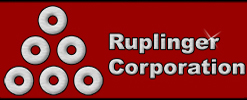Technology Tip: Primer on Sensors - part three of three
By Peter Ruplinger
Reprinted from Utah Molders Quarterly Newsletter February 2007
In part two we reviewed limit switches, proximity switches, photo sensors and other on–off sensors, all of which fall into the category of discrete sensors. In this section we will discuss analog sensors. Do not neglect to read manufacturer’s safety precautions as well as installation and operating instructions.
Discrete sensors are either on or off. For example, the pressure sensor on an air compressor is discrete. It closes contacts signaling to the pump to turn on when the pressure is low. When the pressure rises the sensor opens its contacts, turning the compressor off.
Analog sensors provide a continuous signal, but it varies in intensity. For example, a pressure signal on a hydraulic line may send a four to twenty milliamp (4-20 ma) signal to a microprocessor. The microprocessor would interpret this signal to determine the exact pressure in the line. With a discrete sensor the microprocessor would just know if the line had low or high pressure. With an analog sensor the processor would know the exact pressure and direct the pump to respond appropriately.
Traditionally, microprocessors on molding machines have been programmable controllers. Programmable controllers are off the shelf processors manufactured by General Electric, Omron, Allen-Bradley and numerous others. They are very fast and industrial hardened for the factory floor. Molding machinery manufacturers can easily program them for their specific needs.
In recent years many manufacturers of molding machines have switched from programmable controllers to Pentium based processors of their own design. Pentium based processors are now faster then programmable controllers and, with proper isolation, do well on the factory floor. A molding machine may have two processors, one for controlling the machine and one for operator interface and program storage.
The result of analog sensors with microprocessors is a much tighter control. For example, the discrete pressure sensor on an air tank might typically regulate the pressure from a low of 90 psi to a high of 110 psi. An analog sensor with a microprocessor could regulate the pressure form 95 to 97 psi. Obviously if you are dealing with shop air, the pressure is not critical, but if you are regulating the hydraulic system on a molding machine precise control it is essential.
In a molding operation analog sensors typically measure temperature, pressure and sometimes position. The signal sent to the microprocessor is commonly 4 to 20 milliamps, 4 being at the low end and 20 at the high extreme. Some sensors use voltages instead of milliamps, for example, 1 to 5 volts D.C. or negative 6 volts to positive 6 volts. The microprocessor is programmed to scale this signal and convert it to pressure, temperature, or units of linear position. The microprocessor will then send a signal to valves, relays or motors to regulate the system.
Because the electrical signals used by analog sensors are so minute, care should be used when wiring. Leads are typically shielded to prevent electro-magnetic interference from other electrical devices. Never the less, an analog signal wire should never be placed in the same conduit or directly adjacent to a power conducting cable. As you can imagine, a 480 volt conductor or even a 110 volt conductor can easily alter a signal as low as one volt at four milliamps. Grounding is also important. Some analog devices ground one of the signal leads. Follow manufacturer’s instructions carefully.
Proportional Integral Derivative (PID) Controllers
